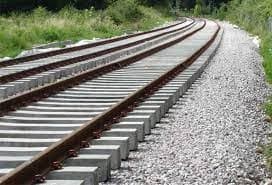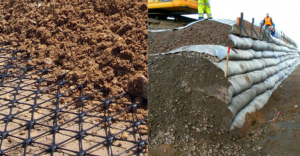Geosynthetics for Railway ballast stabilization
The global rail infrastructure market is growing rapidly and will soon reach a market size by 2025 of USD 61.4 billion. The rail infrastructure market globally is adapting to newer technologies to accommodate a growing population, rise in traffic, and robust demand. Economic growth, growing urbanization, and an increasing need for a faster yet economic mode of transport are the leading market drivers for the railway sector. A boon in civil engineering and infrastructure, geosynthetics have innumerable benefits, the most significant of which is railway ballast stabilization. Ocean Geosynthetics provide geosynthetic engineering solutions for the railway sector at cost-efficient prices.
Of foremost importance in the railways is the maintenance of the substructure. Inadequate substructures can lead to track degradation and decreased lifespans of the rail fastening system, leading to decreased operational capacity and increased maintenance cost.
A railroad track substructure basically has four components, the ballast, sub-ballast, drainage, and subgrade. While the ballast provides a strong trackbed, helps distribute loads, and allows drainage, the sub-ballast is a barrier between the ballast and subgrade, providing more strength in case of a weak subgrade. The subgrade usually depends on the natural environment, and effective drainage is essential to direct the runoff water away from the track.
Role of Geosynthetics in the railway sector:
Whether it is new track construction or rehabilitation, there is enormous use of geosynthetics like geogrids, geocomposites, geocells, and geotextiles in the railway sector.
Geotextiles (resistant to puncture and tear) help with separating track layers supporting structures of different sizes and properties and also preventing the penetration of granular particles onto the subgrade. This helps maintain the integrity of granular layers and increases track life.
Ballast Stabilization: For reinforcement, geosynthetics like geotextiles, geogrids, and geocells, when installed over unstable or soft subgrades, improve efficiency by increasing load bearing capacity and better stress distribution. This is nothing but strengthening the railway ballast.
Ballast pockets are a common issue that leads to track geometry degradation. These are depressions beneath the ballast layer formed when ballast particles penetrate the subgrade forming pockets collecting moisture. The presence of ballast pockets warrants more track maintenance and results in a lower operational capacity.
Improved and stabilized subgrade material, installation of proper ballast drains to drain off the excess water, and stabilizing the upper ballast are all remedial measures for ballast pockets.
Geotextiles, with their permeability and retention properties, also act as a filter layer allowing free movement of water without disturbing or dislodging the subgrade.
Proper drainage is highly critical to prevent track deterioration. Towards that end, geosynthetics like drainage geocomposite that are resistant to mechanical damage are useful when installed at relevant points. They provide cross-track drainage, preventing the accumulation of water.
Geosynthetics offer strength to the railway substructure resulting in stronger, safer, and robust tracks at economical prices. The geosynthetics, with their ability to withstand severe conditions from the mechanical stress of ballast to dynamic loads transmitted by rails and even diverse climatic conditions, are most suitable for the railway sector.
The premium geosynthetic manufacturers in India, Ocean Geosynthetics, have various solutions for the railway sector. Whether it is trackbed construction, subgrade erosion and stabilization, track ballast stabilization, capping layer stabilization, or proper drainage, we have products for every engineering challenge you may encounter.
Contact Ocean Geosynthetics for robust and smart solutions at smart prices.



